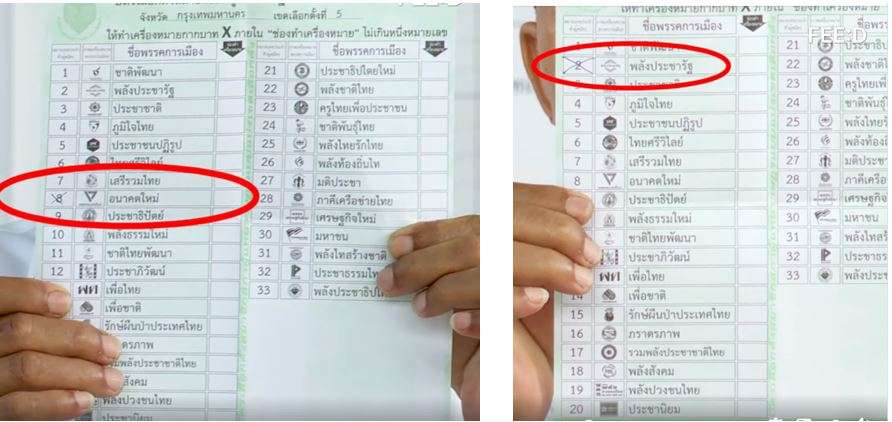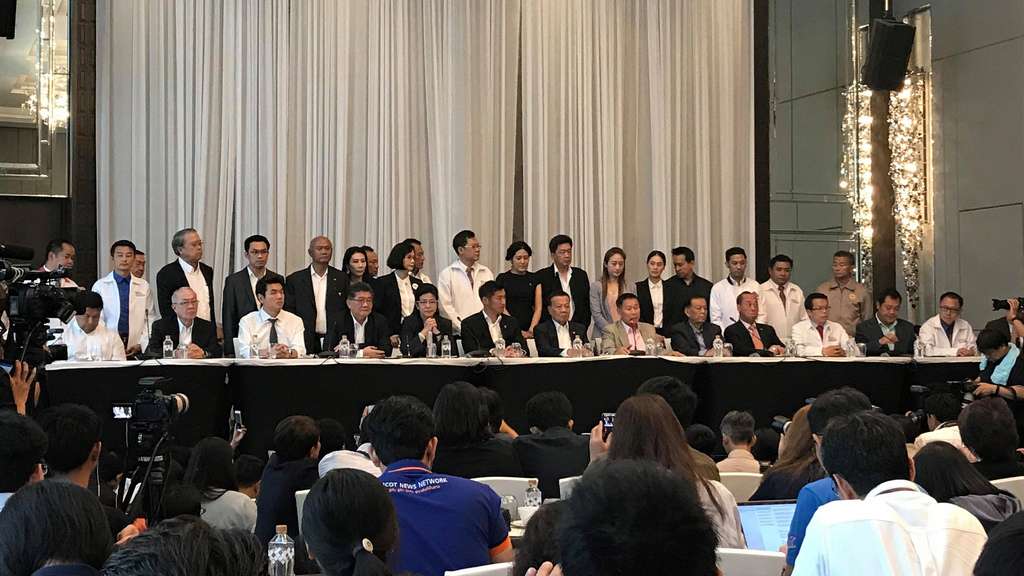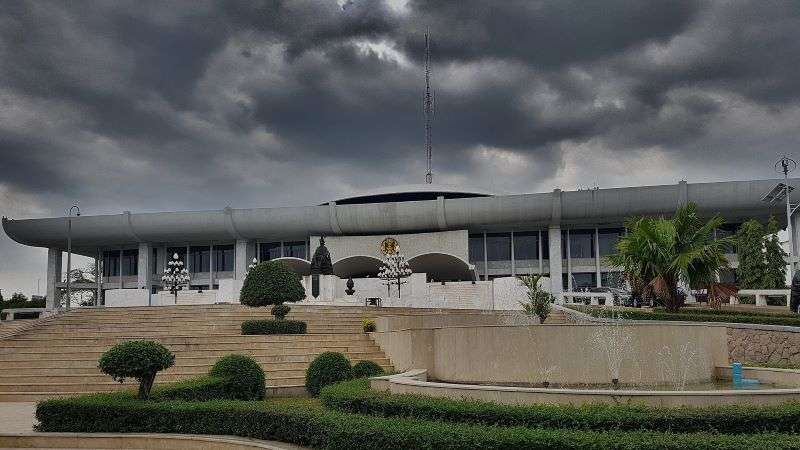Mixed Member Apportionment System (MMA)
MMA, a newly designed electoral system, is unique and presumably, Thailand is the only country in the world that runs its election with the MMA system. With this system, a voter has only one vote (one ballot paper) and that vote will count for both, a constituency seat (350 seats) and a party list seat (150 seats). There are a total of 500 seats in the lower house of parliament. The party list seats of every party will be calculated by the total number of votes that a party receives from the constituency vote nationwide. This calculation will cap the maximum seats that one party should have in the parliament. This is the intention of those who designed the election system to decrease the domination of parliament by major parties while medium-sized parties will gain more seats. As a result, the future government will be made up by several parties, which could weaken the administration.
Free and Fair Election?
There are many complaints that the recent election in Thailand was rigged. The roles of the Election Commission of Thailand (ECT) were already questionable with regard to overseas voting and early voting. First, the election was postponed from 24 February to 24 March 2019. The overseas voters faced obstacles from unpreparedness and mismanagement of the ECT, Thai embassies and consulates, and relevant government agencies, for example, having to wait for hours at the poll; ballots not arriving in the mail; and documents with a candidate’s name printed under the wrong party. Especially problematic was the delayed delivery of ballots from New Zealand, which led to the invalidation of all 1,542 ballots. During the early voting on 17 March 2019, the ECT received criticism that they were also unprepared for organizing the election to accommodate the high volumes of early voters, approximately 1.97 million voters nationwide. These criticisms include: no lists of candidates for voters, long waiting times and being given ballot papers for the wrong constituency.
As for the recent election on 24 March 2019, voters reported irregular incidents related to the election. Those include: the number of ballots exceeded the number of voters in some areas, inconsistent results between the polling stations and the announcement of results by the ECT, improper counting despite the wrong mark at the number and a huge number of invalidated ballots (approximately 2.1 million ballots).

A ballot for Future Forward Party (left) is invalid while a ballot of Palang Pracha Rath Party (right) is valid despite the fact that both were wrongly marked, source: Feed for future
On 28 March 2019, the ECT released the unofficial results of the election. However, the final results will be certified by 9 May 2019, because the ETC claims that they need to investigate and resolve electoral fraud complaints. Until that time, the number of Members of Parliament (MPs) may be changed if any fraud complaints are verified. There are discrepancies between the results (94% of ballots counted) reported by the ECT on 25 March and the recently reported results (100% of ballots counted). These suspicious discrepancies include a difference in the total number of eligible voters, an increase of over 34,000 from the first announcement; a difference in the numbers of voters and numbers of ballots cast; an increase in the number of voters by over 8% or 4,493,145 ballots from 24 March to 28 March; and a discrepancy between the number of votes counted and total votes of all parties.
Consequently, these led to the big controversy whether the recent election was free and fair. Also, it is questionable whether the ECT is transparent and accountable. The Asian Network for Free Election (ANFREL) stated on its interim report that “…while there were only minor mistakes to report as the counting process began, the subsequent tabulation and consolidation of ballots were deeply flawed, which led to an announcement of some preliminary results that were wildly inaccurate on election night… ANFREL invites the ECT to release comprehensive election results as soon as possible in order to foster trust in the general public’s eye.” Currently, there is a petition campaign to impeach the ECT because of its mismanagement and a lack of transparency in organizing the election. As reported, more than 800,000 people signed the online petition campaign on change.org while the law requires 20,000 written submissions for starting the legal process. University students across the country are now collecting signatures on the printed version of the petition.
Who won Thailand’s Election?

Source: Bangkok Post
Even though the results of the election have not been endorsed yet, it seems that Pheu Thai Party (PTP) may gain majority of MPs with 137 seats (without any party list seats) followed by approximately 118 seats (97 constituency seats plus 21 party list seats) gained by Palang Pracha Rath Party (PPRP), the pro-junta party. Both claimed victory and legitimacy to form the future government. The PTP claims that they should form the government as they gained the highest number of seats in the parliament while the PPRP claims that they gained the popular vote, accounting for 8.4 million votes against 7.9million votes of the PTP. Both parties are approaching other parties to make coalitions for forming a new government. However, it seems to be clear that the party with the highest number of MPs should take the lead in forming a coalition government in compliance with the parliament system. In this case, medium-sized parties such as Future Forward Party (87 MPs), Democrat Party (55 MPs) and Bhumjaithai Party (52 MPs) become important allies to form a government.
Peace, Order and Economic Prosperity?
The leaders and members of the PPRP, the pro-junta party that received surprising results from the election, have benefited from the military’s five-year rule in one way or another. It is interesting to see that the last campaign of the PPRP focused on issues related to peace and order of the country, for example, the campaign “ensured peace and order if people choose PPRP and Prayuth as the Prime Minister”. The party may have gained votes from such political rhetoric. In addition, prior to the election, the military government injected a lot of money into the economic populist policies, including the state welfare cards for the poor and low-income people (THB 3.79 billion); the village and urban community fund (THB 200 billion); and the schemes to support rice farmers (THB 51 billion), rubber farmers (THB 17.5 billion) and oil palm farmers (THB 3.45 billion). However, it is possible that the schemes are merely a ploy to pre-emptively gain popularity before the general election 2019 among the lower-income people in Thailand, who account for two-thirds of the voters. Further study and investigation need to be conducted to ascertain the role of these schemes in ensuring PPRP’s success in these elections.
Another key factor of the success of PPRP could be that the PPRP pulled51 candidates from other parties such as PTP, Democrat Party, Bhumjaithai, Phalang Chon Party and Chart Thai Pattana Party, etc., to join PPRP. This was an intentional and crucial tactic of the party to use the existing patron-client networksof influential persons at the local level for the election. As a result, 41 candidates succeeded in securing the polls and 34 of them gained constituency seats from provinces. Clearly, patron-client politics are still effective in Thailand.
Futuristas and New Politics
The Future Forward Party (FFP) expresses explicitly to be a party for the new generation. The FFP attracts voters because of its fresh politicians and policies. Its supporters name themselves Futuristas. Thanathorn Juangroongruangkit, the party leader, has a strong ideology and ambition to reform Thai politics, society and economy. The party has gained popularity among youth, especially first-time voters, who number approximately 7.3 million. The FFP gained 30 constituency seats beyond their expectations and may get 57 MPs from the party list. This implies that Thai voters are ready for change in Thai politics.
The FFP has set three conditions to join a coalition in the parliament, including revising the 2017 constitution, eliminating the legacy of the junta government, and calling for military reform in line with democratic principles.
Dissolution of Thai Raksa Chart Party from the Political Earthquake
Thai Raksa Chart Party (TRCP) was a party allied to Thaksin Shinawatra, the former Prime Minister of Thailand between 2001 and 2006. TRCP, Pheu Tham and Pheu Chart parties were strategically established to ensure that PTP won the election, and are considered as proxy parties for PTP.
However, the political earthquake on 8 February 2019 was the turning point for TRCP. On that day, the party proposed Princess Ubolratana Rajakanya, the elder sister of the King Vajiralongkorn, as the party’s candidate for Prime Minister (PM).On the same day, His Majesty the King decreed that the princess could not be a PM candidate since she is still one of the royal family members. Traditionally, a royal should not be involved in politics. While the TRCP accepted this traditional norm, the ECT, following public petitions, filed a request to the Constitutional Court to dissolve the TRCP for allegedly infringing the political party law by proposing the Princess as the MP candidate. Later, the TRCP was dissolved, its 13 executives are banned from politics for 10 years, and none of the party candidates could run for the election.
After the dissolution, a group of TRCP members campaigned for democracy by advocating that people support pro-democracy parties. FFP seems to have benefited from this strategy because it gained some constituency seats from provinces such as Chachoengsao and Phrae Provinces that were TRCP strongholds.
Democrat Party, it’s time to reform
The rise of some parties may lead to the fall of other parties. The Democrat Party (DP), the oldest party in Thailand, is the obvious example in this election. The DP acquired 159 MPs in the previous election in 2011 whereas it may only gain approximately 55MPs from the recent election (33 constituencies and 22 party list seats). The party lost their seats to new parties, particularly PPRP and FFP. Surprisingly, the party could not win any constituency seats in Bangkok. As a result, Abhisit Vejjajiva resigned as the head of the party after the poll ended. It is time for the DP to learn from its previous standpoints, ideologies and actions in Thai politics in the past two decades. Currently, the party executives will run the party after the election.
The Next Chapter of the Thai Politics
As already said, there are many irregularities in this election that need to be properly addressed. First and foremost, the ECT should resolve irregularities and suspicious incidents appropriately during the election to prove that the recent election was truly free and fair. Protesters, who are dissatisfied at the mismanagement of the election by the EC, gathered at the Ratchprasong and Victory Monument areas in Bangkok on 31 March 2019, with calls to impeach the seven election commissioners. They called for the ECT to disclose election results from all the polling stations to prove that the election was really free and fair.
Second, the delay in the formation of the government will create a vacuum of democratic power. Currently, anti-junta parties, including seven parties (PTP, FFP, Saree Ruam Thai Party, Prachachart Party, Puea Chat Party, Palang Puang Chon Thai Party and New Economics Party) are forming a coalition with approximately 253 MPs to establish the government. They have called other parties to join the coalition to eliminate the legacy of the junta government. It seems that the future government will not be formed until the final results are certified by the ECT by 9 May 2019 as many parties, including the pro-junta government parties, expressed that they will wait for the certified results. Nonetheless, the anti-junta coalition will face another obstacle in selecting the Prime Minister, as 250 junta-appointed senates are key actors in this process. In order to select the PM, the anti-junta coalition needs a total of 376 MPs out of 750 MPs (from both, lower and upper houses) to support them.

The heads of 6 anti-junta government parties signed the MOU to be a coalition to abolish the legacy of the junta government, source: Prachatai
Third, it is undeniable that the current constitution enables the junta and its allies to remain in power. This includes the electoral system and the roles of 250-appointed senates in selecting the PM. Hence, it may not an easy task for the democratic bloc, as claimed by the anti-junta government parties to win this political struggle.
Last, the recent election may further fragment politics in Thailand. As of writing, the political turmoil has divided country into the democratic bloc and the pro-junta bloc.
Nonetheless, it will move Thailand to the new political era.
* The number of party list seats may be adjusted after the election results are finalized by the Election Commission of Thailand.
[Top photo: The former building of the Thailand Parliament at Dusit district. Source: Wikimedia Commons]










